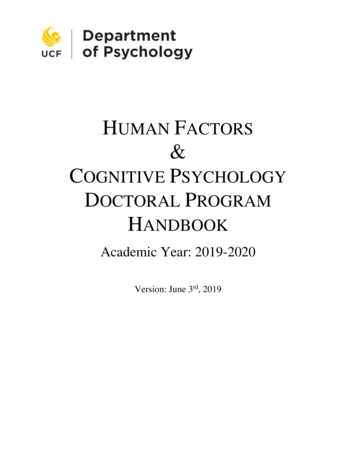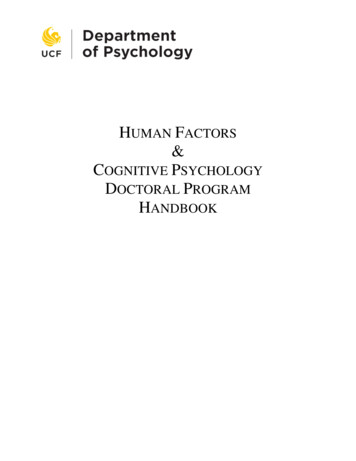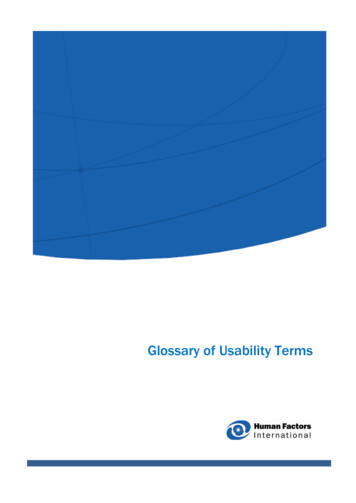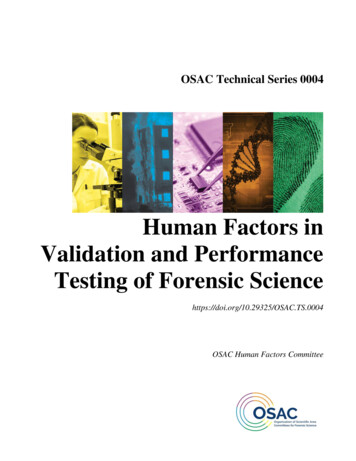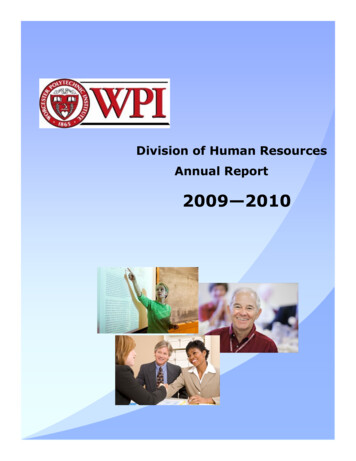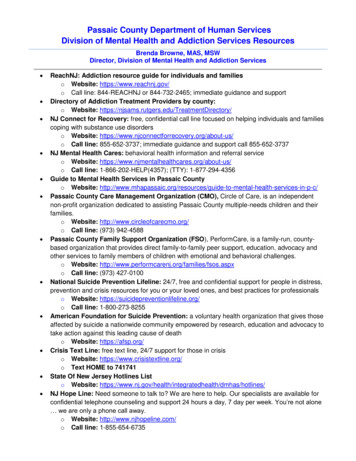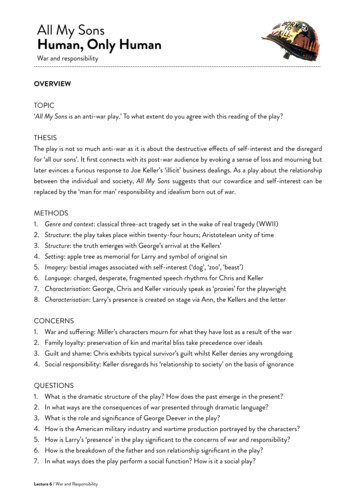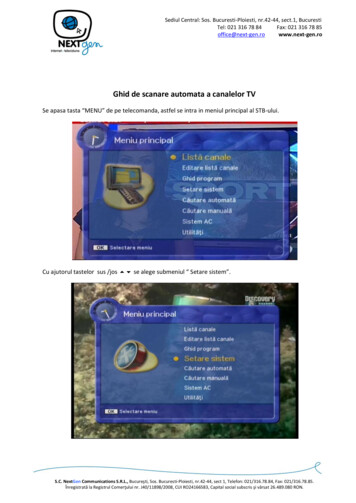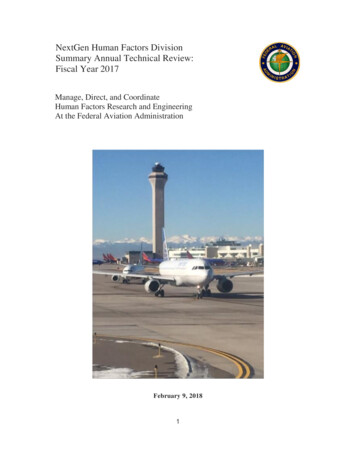
Transcription
NextGen Human Factors DivisionSummary Annual Technical Review:Fiscal Year 2017Manage, Direct, and CoordinateHuman Factors Research and EngineeringAt the Federal Aviation AdministrationFebruary 9, 20181
FAA Order 9550.8, Human Factors Policy, defines human factors asfollows:“Within the FAA, human factors entails a multidisciplinary effort togenerate and compile information about human capabilities and limitationsand apply that information to equipment, systems, facilities, procedures,jobs, environments, training, staffing, and personnel management for safe,comfortable, effective human /media/Order/9550.8.pdf2
To the Aviation CommunityOver the course of 2017, the NextGen Human Factors Division (ANG-C1) continued to deliverhigh value research products and engineering services that support FAA goals for safety andefficiency in aviation systems and operations. Our efforts addressed research requirementscoming from three FAA lines of business, specifically the Office of Aviation Safety (AVS), theAir Traffic Organization (ATO), and the Next Generation Air Transportation System (NextGen).We addressed research requirements that spanned near-term human performance issues as well aspre-implementation human factors with NextGen technology and automation. We also providedthe backbone for the human factors discipline across the FAA as demonstrated by hostingsemiannual Human Factors Reviews with national and international participation.Underpinning our approach is the business model of Research to Reality as shorthand to explainthe paths that sponsors, industry, and others use to transition our products into practicalapplications. The reach of our human factors research and engineering services extends outwardspotentially touching U.S. commercial airlines and air operators, air traffic controllers, air trafficcontrol (ATC) technical and systems specialists, aviation safety inspectors, and acquisitionspecialists responsible for programs in the ATO Program Management Office (PMO).The team of ANG-C1 program/project managers excels in their work providing superior researchproducts on time and within budget. We collaborate with sponsors in portfolio managementto ensure doing the right projects at the right time and producing results that exceed expectations.We systematically apply project management methods with researchers to maximize the valuein doing the projects right. We also apply program management principles to connect projectsbetween ourselves and other offices to avoid duplication, leverage expertise, and integrate results.In addition to the sponsorship from AVS, ATO, and ANG, these research programs leverage theexceptional contributions from scientists at the FAA Civil Aerospace Medical Institute (CAMI)and William J. Hughes Technical Center (WJHTC), other federal researchers at the NationalAeronautics and Space Administration (NASA), and the Volpe National Transportation SystemsCenter, as well as human factors experts in industry and academia. The programs and servicesundergo semi-annual reviews provided by the FAA’s external Research, Engineering, andDevelopment Advisory Committee (REDAC) and several of its subcommittees.The sections that follow provide a cross-section of research from ANG-C1’s four programs aswell as the engineering services supporting the PMO’s acquisition programs. The descriptionsdraw from existing documentation. A new section is added compared to past issues of thisReview providing an Outlook on future NextGen research. I welcome your comments on thisAnnual Technical Review that can be sent to me at Paul.Krois@FAA.GOV.Paul Krois, Ph.D., PMPManager, NextGen Human Factors Division, ANG-C13
Table of ContentsSection 1 — Core (Near-Term) Flightdeck / Maintenance / SystemIntegration Research . 6Section 2 — NextGen Flight Deck Air Ground Integration Research . 9Section 3 — Core (Near-Term) Air Traffic Control and TechnicalOperations Human Factors Research. 17Section 4 — NextGen Human Factors Research: Air Traffic Controland Integrated NAS Design & Procedure Planning (INDP) . 24Section 5 — NextGen Research Outlook . 28Acronyms . 304
Human Factors Research ProgramsTimeFrameNear-TermMid- to Far-TermAir TrafficControlCore ATC and TechnicalOperations ProgramNextGen Integrated NASDesign and ProcedurePlanning ProgramFlightdeckCore Flight Deck/Maintenance/System Integration ProgramNextGen Air GroundIntegration ProgramDomain5
Section 1 — Core (Near-Term) Flightdeck / Maintenance /System Integration ResearchThe purpose of this program is to provide the research foundation for FAA guidelines,handbooks, orders, advisory circulars, technical standards orders and regulations that help ensurethe safety of aircraft operations. It also develops human performance information that the FAAprovides to the aviation industry for use in designing and operating aircraft, and training pilotsand maintenance personnel.Identifying CRMTraining Techniquesin the Airline IndustryCrew Resource Management (CRM) has been implemented into theaviation training curriculum in order to enhance safety on the flightdeck. Due to a lack of standardization, there are differences in CRMtraining administration and assessment methods among airlines. Asa result, a survey protocol has been approved to collect and compareinformation from airlines regarding their current CRM trainingcurricula and assessment methods in order to identify gaps intraining and assessment to help advance CRM towards the needs ofthe modern flightcrew. The approach includes gathering informationrelated to CRM training practices currently being implemented byair carriers in the U.S., Canada and Western Europe. In addition,this research aims at assess the state of Single Pilot ResourceManagement (SRM) training and assessment of Part 135 operators(air taxis). The results of this research serve to provide informationto augment specific CRM guidelines, principles, procedures, andtools that have been developed to improve CRM training andassessment across US airlines, including the update to AdvisorCircular 120-51, Crew Resource Management Training.RotorcraftOperational SafetyResearch is needed to address a number of operational andtechnology challenges for the rotorcraft community that may impactoperational safety. The three research vectors are: HelicopterTraining Devices, Scenario Based Training for parts 61 (FAAapproved flight instructor), 91 (private pilot), 141 (flight schools),and 135 (commercial pilot of non-scheduled charter and air taxioperations, and Helicopter Crew Resource Management (CRM) forPart 91 and 135 operators including Helicopter Air Ambulance(HAA) operators. Research evaluated pilot decision making usingonboard weather aiding resources. Off-nominal event trainingcurrent practices were reviewed for scenario based testing for offnominal events. Overall, this research intends to Increase the safety6
of rotorcraft operations and help reduce the frequency of rotorcraftaccidents.Fatigue Mitigation inFlight OperationsHuman factors researchers supported the Flight Standards Service –Air Transportation Division (AFS-200) by reviewing Fatigue RiskManagement Systems (FRMS) proposals from industry. Thisinvolved review of the scientific integrity of FRMS proposalsduring the processes outlined in AC 120-103A as required forcertificate holders in their demonstration of an alternative means ofcompliance with the new regulations. This included evaluation ofthe review and analysis procedures for FRMS exemption forstandardization and scientific validity. In addition, human factorsexperts contributed their scientific expertise to assist in thepreparation, documentation, review, and release of other fatiguerelated materials as appropriate and associated with 14 CFR Part117 flightcrew member duty and rest requirements. This researchwill be used to develop and update policy for 14 CFR § 117 (flightand duty limitations) and 121 (scheduled air carriers) and OpSpecA318, Authorization to Conduct Operations Under a Fatigue RiskManagement System.Enhancing AviationSafety – IntegratedAngle of Attach(AOA)Research is needed for evaluating existing and potential Angle ofAttack (AoA) indicators that are integrated into the Primary FlightDisplay in order to determine whether they contribute to reducing oreliminating accidents related to stall-spin and other similarsituations. The approach was to define and compare formats ofintegrated AoA instrumentation in the context of flight tasks that aresupportable using AoA indications. The goal was to identify thosefeatures of integrated AoA instrumentation that are critical toproviding usable data to the pilot for defined tasks and to provideguidance/recommendations for the design, certification, and use ofsuch integrated indicators in small GA aircraft. The effort concludedin 2017 with findings from a simulator-based study of integrateddisplays. The research is intended to produce recommendations forminimum integrated AoA indicator display requirements, withoutdiscouraging innovation in the design of AoA display presentations,and is thus expected to enhance safety with better stall marginawareness in existing aircraft and new designs. This was a highpriority research topic for the General Aviation Joint SteeringCommittee and addresses one of the National Transportation Safety7
Board’s (NTSB) Top 10-most wanted issues called Prevent Loss ofControl in Flight in General Aviation.8
Section 2 — NextGen Flight Deck Air Ground IntegrationResearchThis research provides human factors scientific and technical research products for the FAAOffice of Aviation Safety technical sponsors that enable their development of FAA guidelines,handbooks, orders, advisory circulars, technical standards orders and regulations. This importanthuman factors regulatory and guidance material supports the Aircraft Certification and FlightStandards personnel who approve new flight deck displays, devices, and procedures that compriseNextGen capabilities, to ensure that pilots can conduct operations that leverage NextGencapabilities. This research also aligns with the NextGen approach to integrate air and groundcapabilities together to yield increases in air transportation efficiency, capacity, and safety in theNational Airspace System (NAS). Research to assess human performance addressing newNextGen technologies and procedures is necessary for developing updates to standards, FAAorders, RTCA guidance documents, and federal regulations.Pilot Training andCognitive SkillDegradationMitigationIn today’s operational environment, there is no operational baselinefor how much manual flying is done in commercial airlines asindicated by autopilot status and modes. Further, there is noresearch on the impact of automation resulting from use ofNextGen technologies in the long-term. Guidance is needed onhow to use training to mitigate possible cognitive skill degradationfrom increased use of NextGen automation. This research examineshow an increase in automation may contribute to cognitive andmotor skill degradation in manual flight operations, and which mayincrease the chance for errors to be made. To date, focus groupmeetings of subject matter experts (SMEs) have been reviewing theliterature and identifying operational and trainingrecommendations. These recommendations will be furtherevaluated in 2018.NextGen AdvancedInstrument ProceduresFlightcrew pre-flight briefings involve use of briefing strips forInstrument Approach Procedures (IAP). However, complexity ofarea navigation (RNAV) and required navigation performance(RNP) arrival and departure procedures can pose challenges foreffective crew coordination. An assessment was completed on IAPbriefing strips and potential content for use in alternative visualdepictions for RNAV/RNP arrival and departure procedures.Research was also started assessing the pilot’s information needsfor RNAV/RNP arrival and departure procedures. Theseassessments will lead to developing alternative visual depictions ofIAPs that better meet pilot needs. This research provides a scientificbasis for instrument procedure design for NextGen arrivals and9
departures and supports updating Flight Standards 8260 seriesOrders that are related to charting standards.Procedures, Tasks,Skills, and Trainingfor NextGen AirCarrier Pilots andDispatchersAsiana Airlines Flight 214 was a scheduled transpacificpassenger flight from Incheon International Airport nearSeoul, South Korea, to San Francisco International Airport(SFO) in the United States. On the morning of Saturday, July6, 2013, the Boeing 777-200ER crashed on final approach intoSFO.The NTSB found that the 'mismanagement of approach andinadequate monitoring of airspeed' led to the crash of AsianaFlight 214. The NTSB determined that the flight crewmismanaged the initial approach and that the airplane was wellabove the desired glidepath. In response, the captain selectedan inappropriate autopilot mode, which, without the captain'sawareness, resulted in the autothrottle no longer controllingairspeed. The aircraft then descended below the desired glidepath with the crew unaware of the decreasing airspeed. Theattempted go-around was conducted below 100 feet, by whichtime it was too late. Over-reliance on automation and lack ofsystems understanding by the pilots were cited as major factorscontributing to the accident.In 2013 the Flight Deck Automation Working Group of thePerformance Based Aviation Rulemaking Committee (PARC)published a series of recommendations addressing factors thatcontributed to aviation accidents related to Flight Path Management(FPM). Several research studies have sprung from the work of thisimportant Working Group. First, MITRE completed an update ofthe accident and major incident data and analysis contained in theoriginal Working Group report. For the second study, MITREcharacterized the FPM skills including Pilot Monitoring duties andflightcrew Mode Awareness in a line operations environment.Interviews with air carrier flight training departments werecompleted along with a survey of air carrier line pilots. Aforthcoming report from MITRE will inform recommendations toupdate Part 121 training practices for NextGen and provide a basisfor recommendations formed by industry working groups.The FAA anticipates that NextGen will add complexity to theflightcrew’s operational tasks and research is needed on newtraining approaches for these complex operations. An analysis oftasks and focus groups with subject matter experts (pilots,controllers, avionics manufacturers, and FAA certification experts)10
involved a problem-solving and decision-making approach totraining. The results from this research will contribute to thedevelopment of criteria for Flight Standards inspectors whenevaluating air carrier training programs to ensure conformance withFAA regulatory and guidance material (14 CFR Parts 119, 121, and135).The Flight Standards Service identified a need for human factorsrecommendations and guidance to update regulatory and advisorymaterials to address flightcrew performance in managing the flightdeck tasks in normal and non-normal situations. Research wasconducted to define, train and check pilot performance on taskmanagement as part of flight deck operations. The research alsoprovided guidelines to address issues in the NextGen environment,including guidelines for pilot training, operational procedures, andflight deck design.Electronic Flight Bag(EFB) / PersonalElectronic Device(PED)Data from safety reports suggests that pilots rely on electronic mapdisplays/charts more than their paper charts, even though theelectronic medium does not always show all the neededinformation. The presentation of information on electronic displaysand Electronic Flight Bags/ Personal Electronic Devices(EFBs/PEDs) is compelling, that is, the information presented onthose devices draws attention and conveys validity. For this reason,research is needed to identify and evaluate the effectiveness ofpotential mitigations when the EFBs/PEDs are not the best sourceof information. The results of this research will be used to updateregulatory and guidance material for the authorization ofEFBs/PEDs, including AC 120-76C and the EFB/AMM Job Aid.Additional research is being done for EFBs assessing human factorsconsiderations for the display of misleading or inaccurateinformation. This display can result from the loss of informationintegrity and when recognized by the flightcrew can diminish theirtrust in information display. The initial phase of this research isassessing the different ways that pilots may identify misleadinginformation, how it affects their trust of the systems, and what is theproper flight crew response.Advisory Circular 120-76C does not specifically address thechallenge of using multiple EFB applications and the effect onflight crew performance although the circular states that “The EFBsoftware design should minimize flight crew workload and head-11
down time.” This project produced data contributing to the updateof human factors guidelines in Advisory Circular 120-76C.Advanced Vision &Display TechnologyIndustry continues to innovate in developing applications for HeadMounted and Head-Worn Displays. These applications useemerging display features and functions. This research examinesthe use of information with these displays, and potential changes tothe operational evaluation and the certification and approval of suchdisplay-system technologies. The research also identifies the pilotinterface and usability aspects of head-mounted displaytechnologies especially with regards to synthetic-visionapplications.Under the NextGen plans to improve efficiency for aircraft landingunder low visibility conditions, Synthetic Visual Guidance Systems(SVGS) is considered a “key enabling technology.” Use of thistechnology for specific low visibility airport operations involvesHead-Up Displays and Head-Down Displays with 150-ft DecisionHeight and a 1200 or 1400 ft Runway Visual Range at selectedairports. This research will characterize pilot performance toidentify human factors issues and considerations that would affectrecommended changes to operational standards and approvalcriteria for specific SVGS operations. A human-in-the-loopsimulation provides data on specified measures such aslateral/vertical path tracking, stabilized approach, touchdown force,touchdown dispersion, missed approach rates, and workloadmeasures. The results will inform Flight Standards as to minimumtraining, recent flight experience, and proficiency requirements forSVS on pilot Special Authorization (SA) Category 1 (CAT I)approaches.NextGen also aims to improve efficiency for aircraft taking offunder low visibility conditions. The approach uses Enhanced FlightVisual Systems (EFVS) when operational conditions involve lowerthan standard takeoff minima. With regards to takeoff, research willdetermine the minimum airport infrastructure requirements foraircraft equipped with EFVS and could extend the range of weatherconditions in which aircraft could takeoff and increase the safetywith which aircraft could operate at these airports in reducedvisibility. This research will be used to inform new NextGenconcepts of operation and operational improvements. It will informFlight Standards and RTCA-213 in standards development.12
Electronic Data-Driven Electronic data-driven charts (DDC) are automated and interactive,Chartspresenting human factors considerations in the display of en routechart information. With manufacturers beginning to propose DDCsoftware applications, this research will be u
Interviews with air carrier flight training departments were completed along with a survey of air carrier line pilots. A forthcoming report from MITRE will inform recommendations to update Part 121 training practices for NextGen and provide a bas

